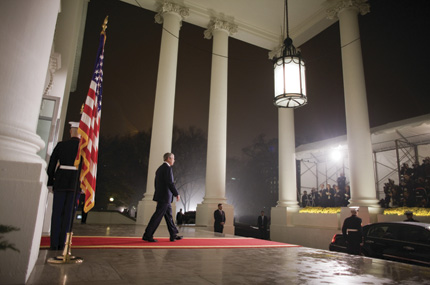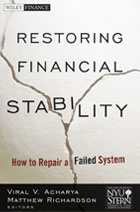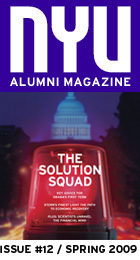Stern Faculty rush to respond with a plan — and Washington listens
by Jill Hamburg Coplan
On Friday, September 12, Viral V. Acharya sat beside boxes of
belongings in his new Manhattan apartment. The finance professor had just moved from London to take a position at the Leonard N. Stern School of Business, but he couldn’t even think
about unpacking. Instead, he sat glued to CNN and CNBC as a fast-moving global
financial emergency unfolded. At the center was Lehman Brothers, the storied, 158-year-old investment house, teetering on the verge of collapse.

For two years, Acharya, a bank regulation specialist and former academic adviser to the Bank of England, had followed the simmering credit crisis, created when risky mortgages, made to borrowers with poor credit histories, went into default, taking dozens of so-called “subprime” lenders down with them. But this was drama of a different order: If Lehman failed, with nearly $650 billion in assets, it would be the biggest bankruptcy in American history. “I had the instinct that evening: This is really going to be a disaster,” Acharya says. “It was like a movie, like something you read about in books.”
He was right. By Monday, September 15, Lehman had not only failed but a nearly insolvent Merrill Lynch had sold itself to Bank of America, and the giants Morgan Stanley and Goldman Sachs were floundering near collapse (and would soon convert from high-flying investment banks into bank holding companies)—all because their enormous stashes of complex, mortgage-backed derivatives now appeared to be practically worthless. The next day, the money-market system underpinning global commerce seized up for the same reason, and the Federal Reserve mounted an emergency rescue of the world’s largest insurance company, AIG. A few days later, Washington Mutual was seized by the FDIC.
At Stern, the conversation in faculty meetings, in the halls, and on blogs went into overdrive. Dean Thomas F. Cooley called for an emergency brainstorming session. The school’s Board of Overseers had asked him for a response to the meltdown—something big, in writing. “At a moment like this, at a business school, with the wealth of knowledge we have gathered, one puts it all in perspective,” Cooley says. The question he posed to his faculty was simple: “What do we really need to do?”
Wiley recently published their answers in the new book Restoring Financial Stability: How to Repair a Failed System. Edited by Acharya and financial economics professor Matthew Richardson, and compiling 18 white papers authored by 33 scholars, the book describes the growth, and implosion, not only of megabanks but of the risky shadow banking system they parked outside the reach of regulators. It documents how investment banks, insurers, hedge funds, and others invested long-term, while funding their holdings short-term—a prescription for runs and instability. Ultimately, the book lays out a new style of “systemic” financial regulation, designed to monitor and defuse emerging dangers in today’s rapidly shifting, deeply interconnected global economy.
In February, the book was in the hands of President Obama’s economic team—Treasury Secretary Timothy F. Geithner and Lawrence H. Summers, who heads the White House’s National Economic Council. Dean Cooley notes that Stern also sent galleys to “the people we know at the Fed,” the Bank of England, and the most powerful policymakers on Capitol Hill. The House Oversight Committee on the bailout requested 10 copies. At press time, when Geithner revealed new plans for the biggest overhaul of financial regulation since the Great Depression, the book’s recommendations were much in evidence. “We have had a role, for sure, in shaping the debate,” Cooley says.
The book, like the crisis, was significant for another reason: Academics, accustomed to spending years on major projects, had to deliver it to the publisher in just six weeks. To get it rolling, professor Ingo Walter, vice dean of faculty, drew up a blueprint, created a faculty e-mail list called CrisisFac, and blasted an announcement soliciting contributions: “This is probably the most important event of our lifetime.” Three dozen economists signed on that day. Richardson, a capital markets expert who runs Stern’s Salomon Center for the Study of Financial Institutions, managed the process.
Contributors gravitated to areas where they’d done research and in many cases advised government. Some had worked on securities and derivatives exchanges, others with central banks and public agencies, such as the Federal Home Loan Bank. They’d testified before Congress on the Savings & Loan crisis, rating agencies, and the 1999 repeal of the Glass-Steagall Act, the milestone that tore down the wall among banks, brokerages, and investment managers—creating the megabank model that, the economists would write in the book, had proven a failure.
Throughout the month that they prepared the book, the Stern economists circulated ideas in hundreds of e-mails. In the home stretch period of comments and revisions, a single economic question posed on the listserv generated 60 e-mails in 45 minutes, and these online debates, Acharya and Richardson say, sometimes flourished at 4 am. Just before the deadline—while the crisis continued and the United States doubled the funds committed to failing insurer AIG and spent $125 billion on equity stakes in major U.S. banks—the authors presented papers at nine back-to-back roundtables. Then Acharya and Richardson pulled six all-nighters to finalize the manuscript.
The book’s recommendations would end up representing a collaborative agreement, reached through weeks of aggressive debate. The most vociferous disagreements were over whether bankers’ pay should be regulated and what role monetary policy should play during a bubble. While they differed on these points, they did agree that financial institutions that pose systemic risk should be forced to buy insurance against catastrophic losses.
The book narrates the years leading up to the financial crisis, when easy availability of credit fueled a housing bubble and a boom in lending during which loan standards plummeted. Banks packaged or “securitized” high-risk mortgages into trillions of dollars of exotic, little-traded instruments, which were bought and sold in an unregulated, over-the-counter market. Unlike with simpler derivatives, such as futures and options, there was no central clearing house where everyone could see who’s trading what. Now, thanks in part to the new book, that’s set to change.
As the underlying risky loans’ interest rates ballooned, homeowners defaulted, and the widely held, complex securities made from those loans started weighing down Wall Street. The mortgage-related derivatives, it turned out, were now toxic and a gigantic problem for any bank that held them. Banking and housing’s declines left Americans feeling poorer, so that even fewer bought homes, which sank related industries—from home electronics to the building trades. Stocks followed suit, creating a dangerous recessionary spiral. The Fed cut interest rates several times but couldn’t rev the economy.
Part of the problem was that rather than greasing the wheels of commerce by turning deposits into loans, the banks had acted like supersized, risky hedge funds. They ignored their own business models, Richardson says. They were supposed to transfer risk by off-loading the complex mortgage securities onto investors. Instead, the banks kept them in-house, like time bombs ticking in the basement. Regulators were too weak to stop them and seemed unable to meet the challenge once the crisis hit. “You got the feeling the regulators didn’t have it all in control—that they were caught without sufficient forewarning, were maybe even in a state of panic,” Acharya says. “Some very natural responses policymakers would have considered, if they’d been researching these issues for a long time, weren’t being considered. That lack of preparedness surprised me.”
By contrast, the Stern economists had spent their careers studying these very matters. The book’s prescriptions for remedying the catastrophe share an approach the editors call “regulation light” —using incentives, such as taxes and fees, yet relying finally on the power of markets (see White Paper Briefs). The fixes also proceed from the recognition that “free markets” aren’t actually free: Government guarantees and subsidies, as the ongoing bailout makes clear, are inevitable features of modern finance. “Once you accept that,” Acharya says, “you can focus on getting the incentives right.” One key challenge is solving the problem of “moral hazard,” the danger that a safety net becomes an invitation to misbehave, because you know you’ll be rescued. To meet that, the economists say, the Fed’s lender-of-last-resort role must stop being ad hoc and unconditional. Instead, emergency help should come with conditions: Banks must hew to limits on leverage and stiffer capital requirements. They should also pay a tax into a guarantee fund, commensurate with the risk they’re adding to the system.
Back at the business school last winter, while students rushed around the elevator banks, Cooley headed to lunch with former Fed Chairman Paul Volcker, now running Obama’s Economic Recovery Advisory Board, to discuss the book. The volume and its authors, Cooley says, “changed the focus from the present to talking about the way the world should be. It was the ultimate teachable moment for a business school.”
PHOTO © BROOKS KRAFT/CORBIS
The new book describes the growth, and
implosion, not
only of megabanks but of the risky shadow banking system they parked outside the reach of regulators.

“This is probably the most important event
of our
lifetime.”
-Vice Dean Ingo Walter
Rather than greasing the wheels of commerce by turning deposits into loans, the banks acted like supersized, risky hedge funds. They ignored their own business models.








